I’ve been into enjoying audio my whole life. One of my first memories as a child was seeing my older brother carefully placing the needle on a Donna Summer’s 12” Remix of Hot Stuff. For the Generation Z readers of this post, a 12” is an extended version of a song on a vinyl record that uses larger grooves to increase dynamic range. Typically, there was the main remix on one side of the record and then another funky remix or a totally different song on the other side.
From that initial introduction to music, I delved pretty deep into the world of HiFi, audiophoolery and everything in between. I was one of those people that had a fully built audio system in my car that cost nearly as much as the car. I was also that person that had $200 Monster RCA cables and $100 power cables. Thankfully, as I got older and came to realize how hard money was to earn (when it wasn’t coming from my parents), I settled down into an audio journey that was more realistic, achievable and with a higher return on the money spent.
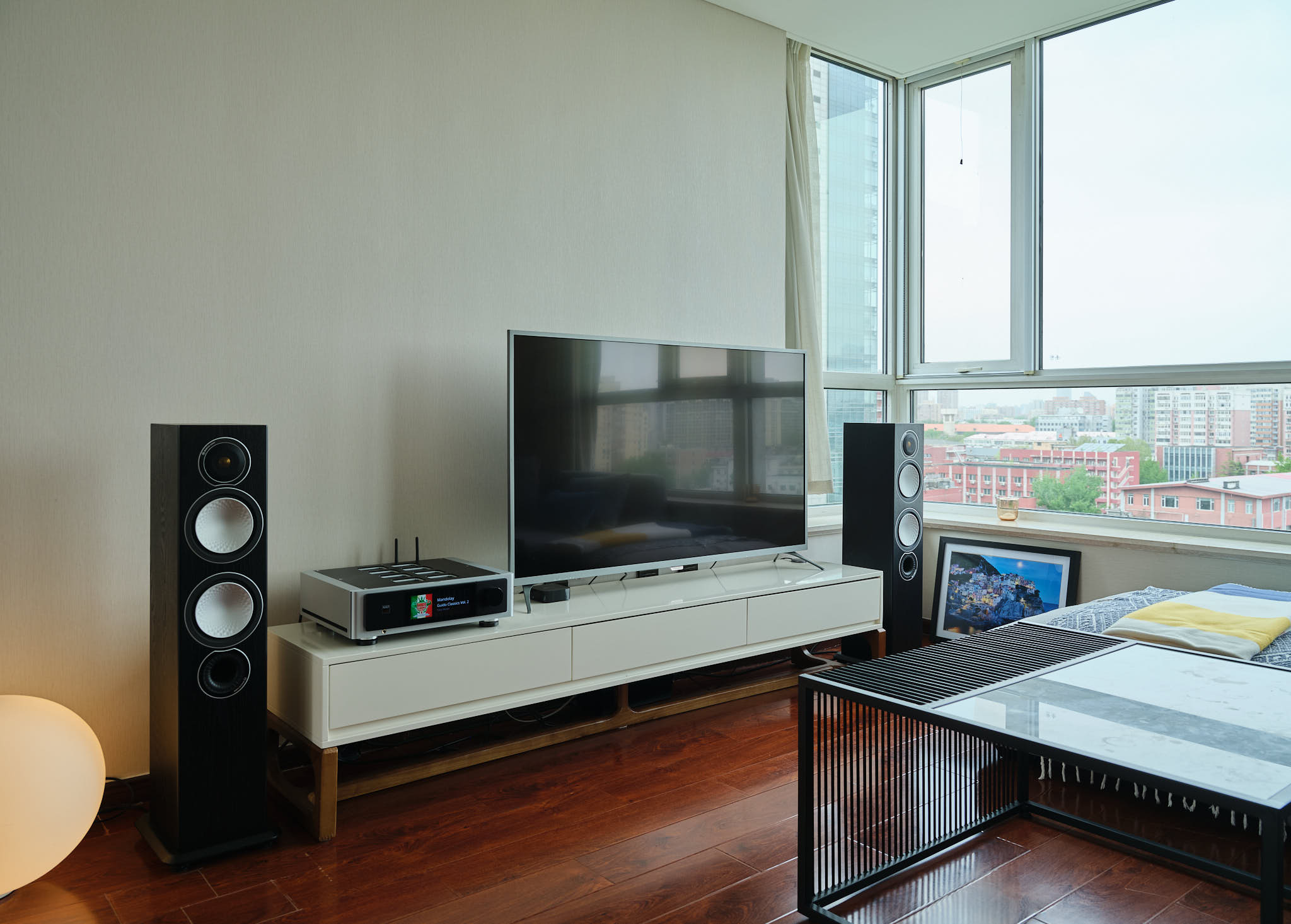
Brands like NAD, Creek Audio and Cambridge Audio replaced the more esoteric gear I used to crave for. Gone were high-end speakers with sleek marketing that actually said nothing about their real life performance; In their place, speakers from brands such as Monitor Audio, Revel, KEF and Wharfedale humbly took their place and thrived in my listening environments. Throughout this audio journey, I came to realize that good sound comes mostly from two things:
- Room dimensions and materials
- Speakers and their placement
I had spent so much money on amplifiers, each time hearing major improvements, only to later realize that as long as the amplifier is not clipping, any sound gains are mostly illusionary. I would have been much better off upgrading my speakers or spending some time moving the existing speakers around to maximize their potential. More recently, I’ve learned about a major third pillar to achieving sound improvement.
- Digital Room Correction (DRC)
Digital Signal Processing (DSP) has been around for a long time in home audio. I recall some old Sony AV receivers I owned with various audio modes that made my living room sound like a music studio, a stadium, a rock concert or a theatre. It’s perhaps because of these initial experiences that I came to judge DSP as a gimmick and something not appropriate for an “audiophile” like myself. I couldn’t have been more wrong, and I’ve missed out on years of much better sound quality as a result.
I came to judge DSP as a gimmick and something not appropriate for an “audiophile” like myself. I couldn’t have been more wrong.
In this post, I’ll review Dirac Live’s hardware based room correction capability, as found in many receivers and amplifiers in 2023. Dirac has been at this for a long time. They first broke out into the scene in the early 2000s and targeted the studio crowd, where linear and repeatable audio is very important. Dirac then moved into the home theatre, car audio, headphone and computer markets where they’ve appeared to do very, very well. More recently, their product has found its way into our world, the world of 2-channel HiFi! This is where I came upon my first interaction with Dirac with the NAD M33 I purchased and reviewed in 2020. A review of the M33 can be found here.
What Dirac Live Does
Dirac Live tries to achieve three things:
- Time align the sound from your various speakers so that the sound arrives at your ears at the same time.
- Reduce indirect sound that comes from reflections around the room.
- Improve bass clarity by reducing room modes and attempting to fill in nulls (within reason)
It’s hard for me to overstate how much of an improvement Dirac Live makes as it works to achieve these targets. Most amplifiers with Dirac Live have the ability to quickly A/B with Dirac Live Off/On. The dramatic difference is exceptionally clear to hear, and is so great, I doubt anyone would ever go back to listening to music without engaging Dirac Live again. I know I certainly can’t go back.
Let’s look into each of these objectives one topic at a time.
1. Time align the sound from the speakers
Most home audio setups have to deal with compromising the speakers locations to fit within the main purpose of the room. This can sometimes mean having to offset the speakers left or right vs. the main listening position (MLP). When the MLP is positioned offset to the centre of where the speakers are positioned, sound will arrive from one speaker earlier than the other. The speaker positioned more closely, will sound louder and will pull the soundstage towards that speaker.
For example, if the right speaker is positioned closer to the MLP, the soundstage will be shifted to the right. With modern engineering technology, we expect modern speakers to have good time alignment within the box itself, however some poorly engineered speakers can have sounds arriving earlier from the woofer than the tweeter. This also creates a diffuse soundstage and poor articulation of the intended sound.
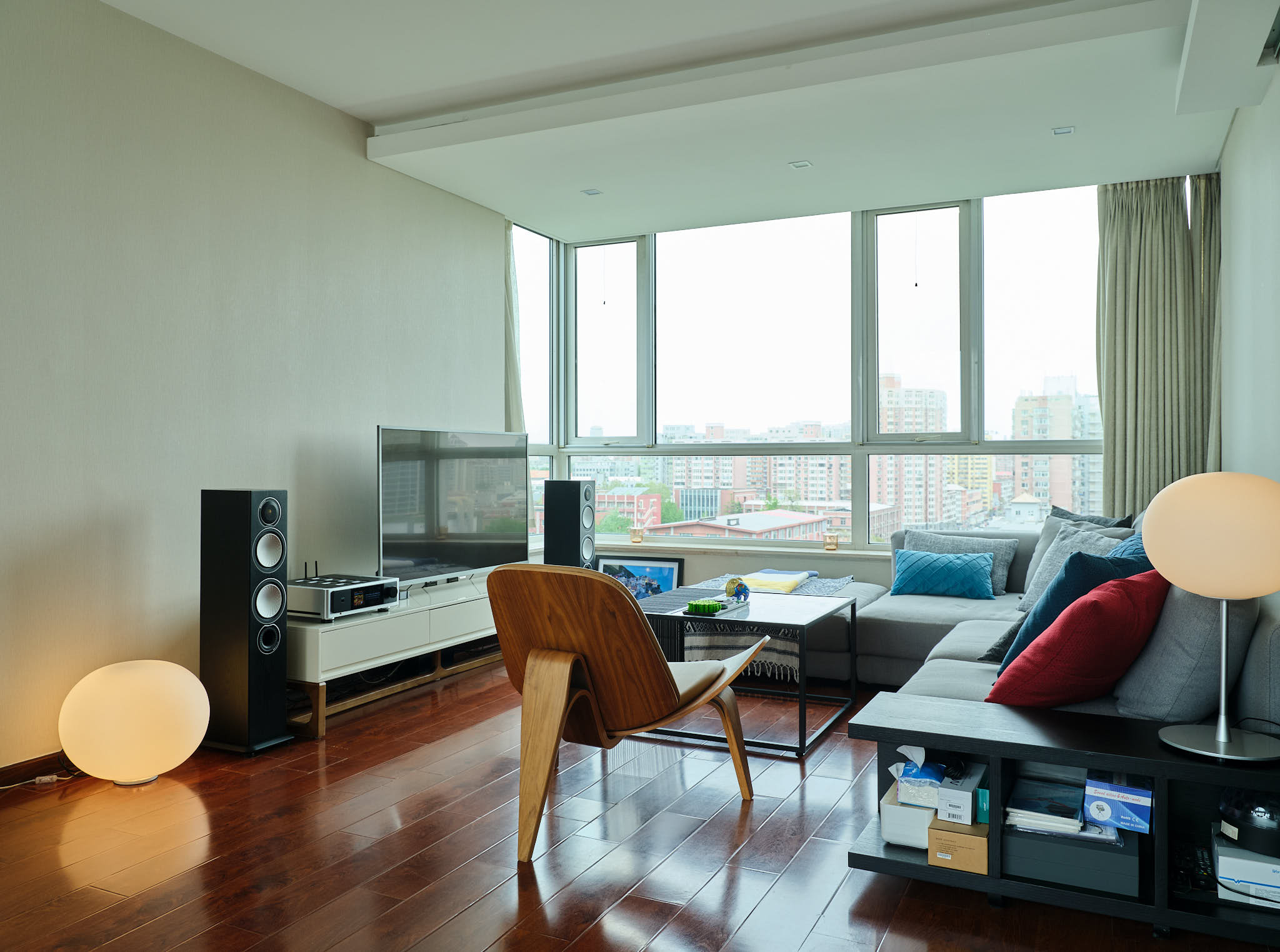
When Dirac Live runs its calibration sweeps at the various points near the MLP, it sends a 20Hz to 20KHz sine wave tone through the various speakers and does complex calculations to ensure that each speaker and every frequency is arriving at the MLP at the same time. In my current living room, I have no choice but to sit offset from the two speakers connected to the M33. With Dirac Live off, the soundstage is tilted to the closer speaker (right side) and because of a window near the right speaker, the soundstage is also very diffuse in addition to being off-centre. To slightly remediate this, I can adjust the balance to the right, but it doesn’t come close to what Dirac Live can do.
With Dirac Live on, the phantom centre image is rock solid and locked right in front of the MLP.
With Dirac Live on, the phantom centre image is rock solid and locked right in front of the MLP. Some first-time users complain that their soundstage collapses when engaging Dirac Live. I would argue they’ve not yet experienced how a wide dispersion and properly setup speaker system should image. With a set of Revels for example, without Dirac Live, when setup properly away from back and side walls, they cast a rock solid centre image that nearly matches what Dirac Live can achieve with lesser speakers.
To illustrate this point, let’s look at some graphs from the amazingly well designed (and FREE!) Room EQ Wizard (REW) software. I recently picked up a UMIK2 from MiniDSP, however I recommend that people buy the UMIK1 as I’ve found little practical rationale for spending the extra money on the lower noise floor of the UMIK2. I had a one-off requirement for the low noise floor, got the measurement, and now have no real use for it beyond what the UMIK1 was already capable of.
We’re going to look at two graphs. The Impulse Response (IR) graph shows when the signal arrives at the MLP and also the subsequent reflections. For the purpose of time alignment, we’ll look at only the first response, the peak. If your speakers are setup correctly, the IR peak will overlap between the left and right channels (in a two channel system). As mentioned, I have to sit offset in my current room, so with Dirac Live off, we should expect there will be a timing issue between the two speakers and that’s exactly what REW shows.
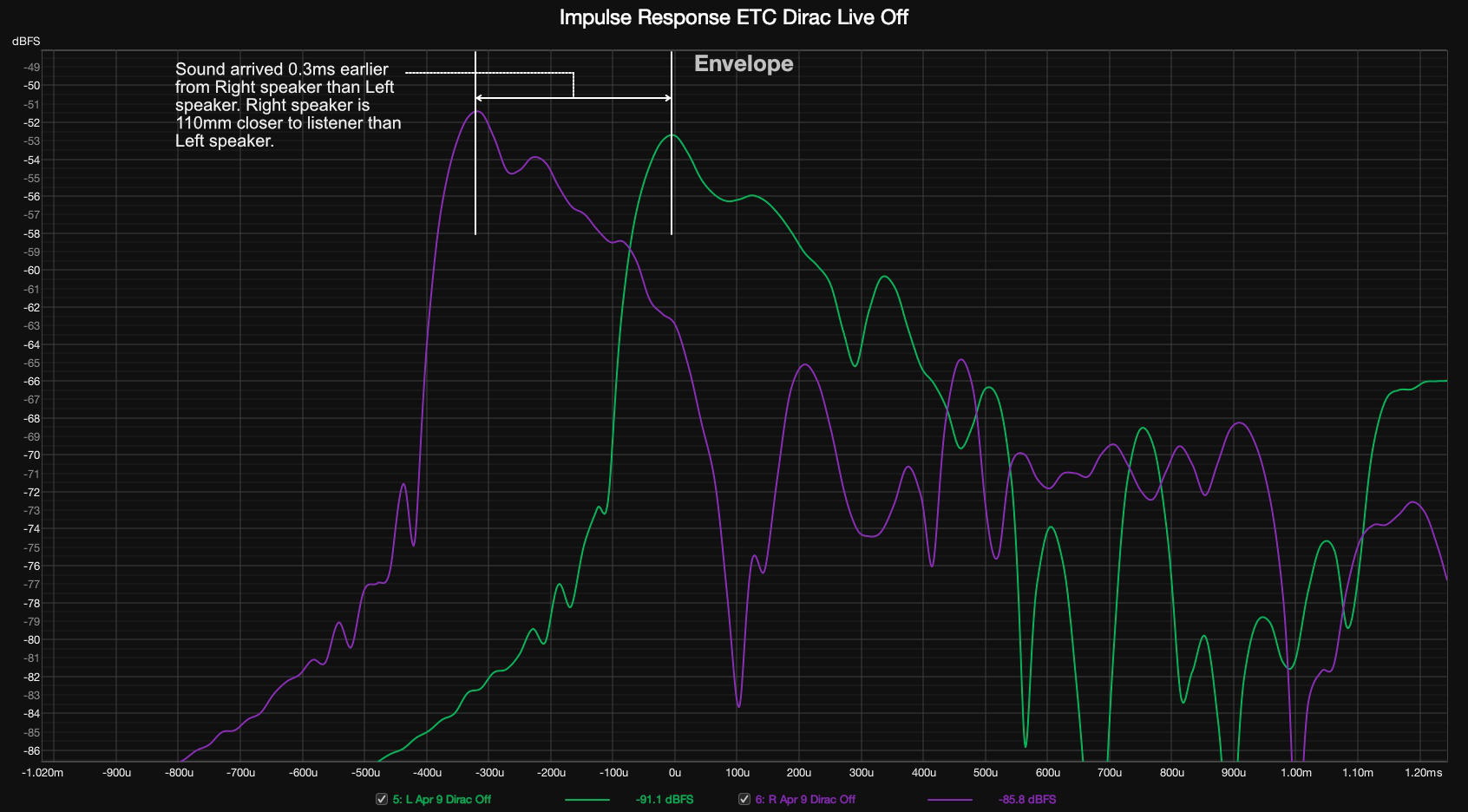
With Dirac Live off, the sound from the right speaker arrives 0.3ms earlier than the left speaker. REW shows that the right speaker is 110 mm closer to the MLP than the left speaker. To show how accurate REW is, I used a laser measuring device to confirm the distance from the MLP to the speakers. It’s incredible how useful REW is and that John provides it for free. The measurements are as follows:
| Distance to MLP from L Channel | Distance to MLP from R Channel | Difference | |
|---|---|---|---|
| Laser Measurement | 2970 mm | 2851 mm | 119 mm |
It goes without saying, but if you do have some flexibility, it’s always ideal to move the speakers to align them before doing a Dirac Live measurement. However, in my room, there is no option to further move the right speaker out because there’s a window there. You can use REW to know how much to move the speaker and confirm the time alignment with before/after measurements.
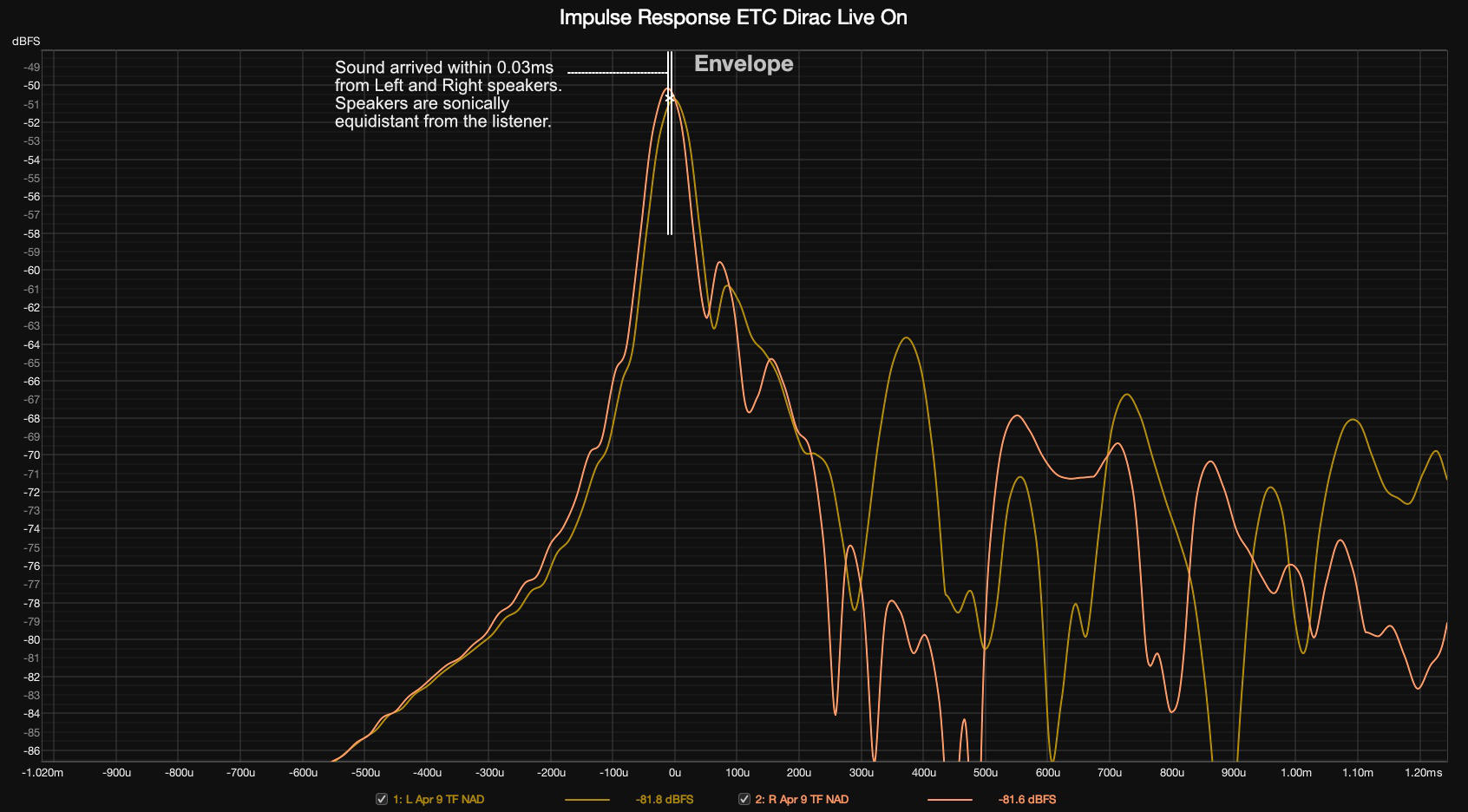
With Dirac Live on, the magic happens. Without physically moving any speakers, you can see that the time alignment is right on now. Both speakers are sending audio to the MLP at the same time, such that the phantom centre imaging becomes rock solid in front of the MLP. The audio arrives within 0.03ms of each other; even this small difference is due to the microphone not being placed in the exact location due to taking the Dirac Live and REW measurements on different days.
2. Reduce indirect sounds from room reflections
My listening room is a huge compromise for audio sound quality. It’s about the worst possible listening environment that you can conjure. It has hardwood floors, a marble coffee table, windows along one side next to the right speaker, a large open area to the left of the left speaker, a large open hallway perpendicular to the listening room, and a kitchen with a flimsy door near the MLP. When I first rented this apartment, the echo was unbearable; with some furniture in the room, it improved, but still left a lot to be desired. Since it’s a rental, I need to make the best of what I have.
Dirac Live again does some magic here using filters and likely some proprietary methods (Dirac Live White Paper [PDF]) to reduce the unwanted indirect reflections from the room. Some reflections are good since any concert environment or venue will have reflections, but we don’t want so many that it blurs the direct sound. Using REW again, we can clearly see the impact of Dirac Live on reducing the unwanted sound reflections in the room. The beauty of Dirac Live is that the user doesn’t have to do anything. I didn’t install any panels or move any furniture; this was all accomplished digitally through Dirac Live.


Starting with the left speaker, we can see that the proportion of the highest amplitude indirect sound versus the direct sound has decreased from 85% to 70%. Subsequent indirect sounds have a much lower amplitude across the time spectrum.
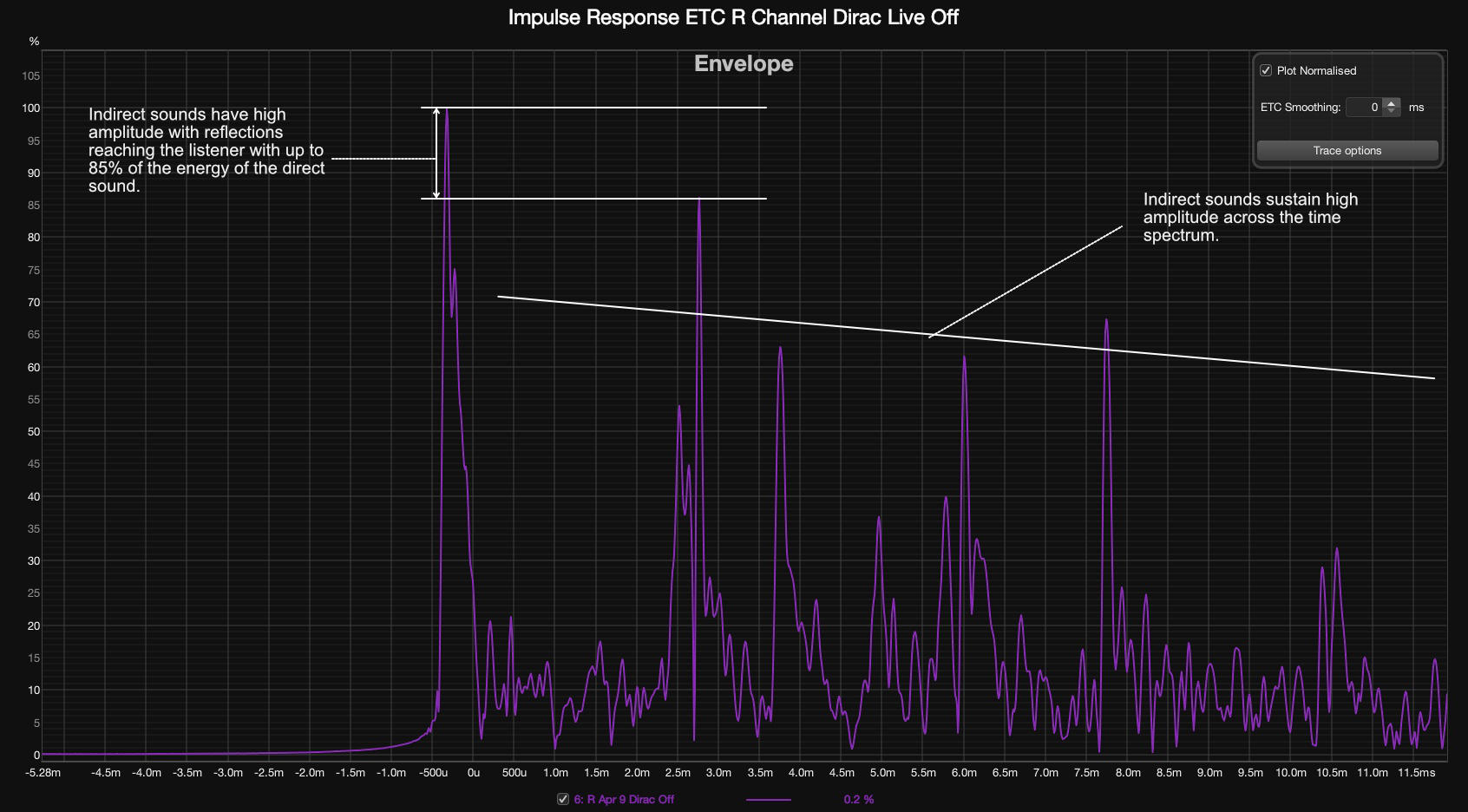
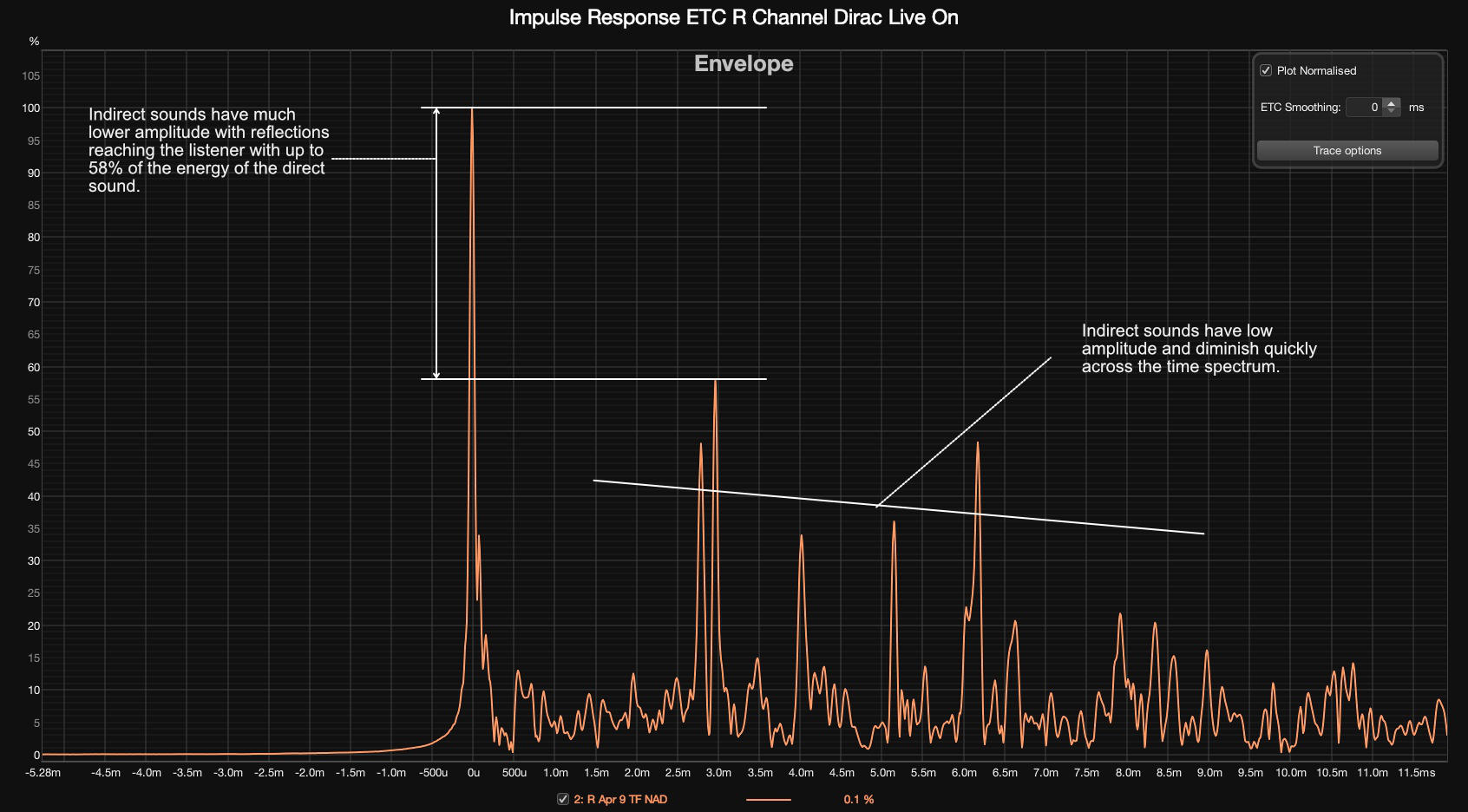
It’s the same story for the right speaker, but here we see an even bigger improvement because the right speaker is positioned close to a large window. Dirac Live is able to reduce the indirect sound dramatically bringing its energy down from 85% to 58% (versus the direct sound energy). The subsequent indirect sounds are equally attenuated by Dirac Live’s DSP technology.
This increase in the ratio between the direct and indirect sound provides the kind of improvement you’d get if you put heavy carpets or curtains in the room. It’s a dramatic difference and I didn’t have to make any changes to my room.
3. Improve bass clarity by reducing room modes and filling nulls (within reason)
Dirac Live is perhaps best known for this capability which is why I left it last. This is one of the more intuitive changes Dirac Live makes because we can imagine adjusting the bass frequencies using a tone control or parametric equalizer. The difference being that Dirac Live can do this across multiple taps, while adjusting phase if necessary, individually for each speaker. Newer implementations of Dirac Live also have Bass Control which enables the main speakers to work with the subwoofer or subwoofers to achieve the MLP’s goals. A further expansion of this technology was announced in Spring 2023 called Dirac Live Active Room Treatment which promises to utilize every speaker (including surround channels) in the room to achieve the goals at the MLP.
In my room, there’s a 15db bass mode centred around 47Hz where there’s a lot of musical content in the Electronic Dance Music that I often enjoy. Without Dirac Live, there’s the sense of a bass note that’s dominated by that one tone. All other bass notes gets drowned out. Furthermore, the mode is so strong that it prevents me from listening to music loud as I’m concerned the neighbours will complain. With Dirac Live on, the bass mode is smoothened out and some of the nulls are also partially filled.
Please note that Dirac Live can’t fill every dip in the frequency curve because there’s only so much power available in the amplifier and some nulls are due to cancellation which cannot be overcome no matter how much power you throw at it; the positive and negative pulses will just increase and offset each other. To fix those types of nulls requires moving the MLP, adding subwoofers, moving the speakers or working on the room itself. However, what Dirac Live does is already more than sufficient to make an enormous difference in the bass sound quality.
You can see in the graph the huge impact Dirac Live makes.
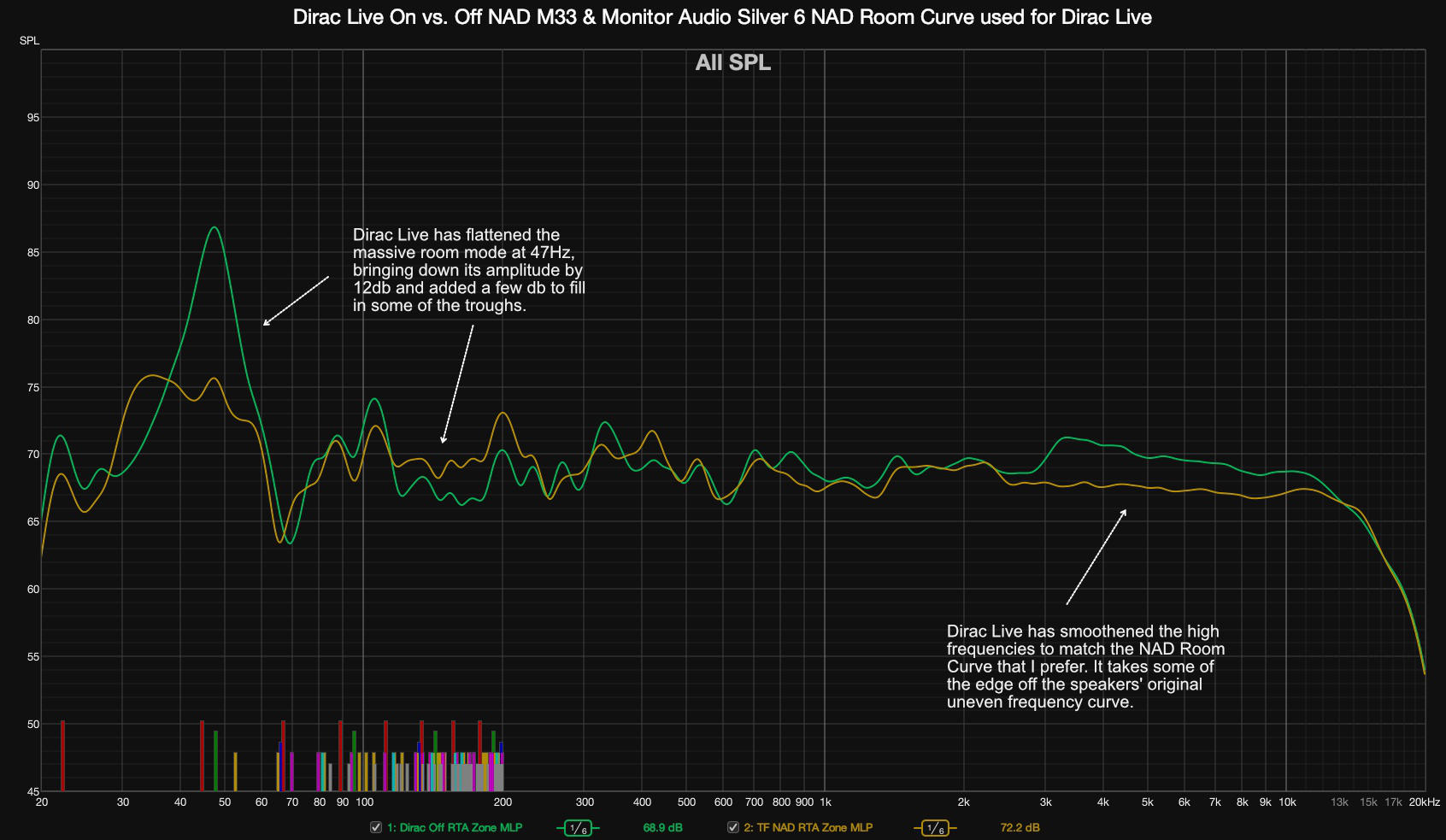
In my room, Dirac Live pulled 12db out of the room mode at 47Hz. Dirac Live can completely flatten it if desired, but I prefer a target curve with some bass in it. You can also see that Dirac Live was able to fill in some dips in the mid bass area, while pulling some excess energy out of the high frequency area. The end result is like having a much better room setup and speakers than what you started with. Furthermore, you can tune the sound to what you like. Want more forward vocals? You can increase the 1-3Khz range; want a BBC sound? That can be dialled in using a Dirac Live target curve.
Dirac Live Curves
When Dirac Live completes the sweep of measurements, it produces a curve of what your current room looks like. You then have the responsibility to set what you want the room to sound like. The latest version of Dirac Live includes a much more intuitive interface to set your desired curve. In earlier versions, the default curve was potentially more faithful to the production of the music, but many felt was too shy in the bass, especially after becoming accustomed to the room modes.
To alleviate that, Dirac Live now uses a clever “shelving” concept where it analyzes your existing speakers and frequency curve and then looks to flatten the major peaks without taking all the bass away. For most well designed speakers, this results in a curve that ends up looking pretty similar to what Harman’s research identified as an ideal MLP curve of +6db in the bass from 20Hz to 200Hz and then sloping down about -1.1db per octave until 20KHz is reached.
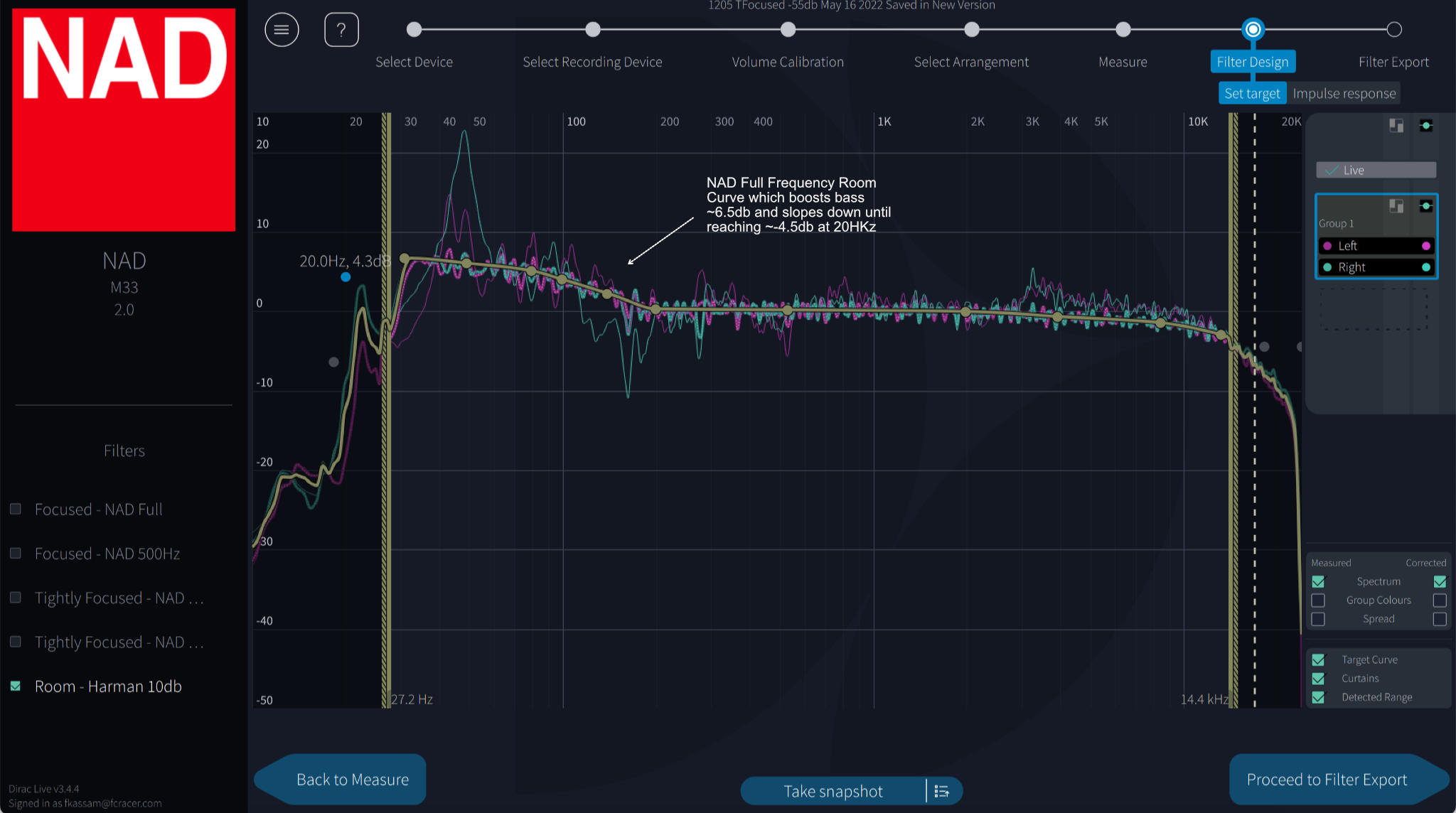
Another option is to utilize a known curve or make one of your own. I personally use NAD’s house curve which follows the Harman one. I like that NAD has toned down the highs a bit since my room is very reflective. There are however times that I want more bass for house parties, and for that, I turn to the Harman +10db bass curve. A link to various curves can be found here. Don’t be afraid to play with the curve and try different approaches to achieve your personal taste.
Limited Bandwidth vs. Full Bandwidth License
Most amplifiers that come with Dirac Live include the limited bandwidth license which allows frequency correction up to 500Hz. For 99% of people, this will already provide a huge gain in audio performance. For those that want ultimate control and/or have speakers with non-optimal, non-linear frequency characteristics, they can consider spending the $99 on the full bandwidth version which allows frequency correction from 20Hz to 20KHz.
I personally use the full version since my room is reflective and one of the Monitor Audio Silver 6 speakers is positioned near a large glass window; the ability to tone down the high frequencies makes for more enjoyable long listening sessions. I should note however that experts such as Floyd Toole recommend not to correct in-room frequencies above the Schroeder frequency, sometimes called the transition frequency. In most residential rooms, it’s between 250Hz and 500Hz.
Conclusion
Dirac Live has opened my eyes to the power of Digital Signal Processing in the two channel world. It’s the single best thing I’ve done for my home audio enjoyment. The main reason for writing this post is that I wish I had learned about it sooner, so I hope that this will inspire you to give it a try when you’re looking for your next amplifier. I’d be happy to answer any questions you may have; feel free to reach out in the comments below.
Discover more from fcracer - Travel & Photography
Subscribe to get the latest posts sent to your email.
Hey thank you for providing all this information. I’m new to Dirac, I currently don’t use it. Cause it took away my bass completely.
I wanna ask you how to do, it’s that I’m a bass lover with my two dd18+, I want them to work properly I want the bass to feel in the couch as it does right now.
How do I achieve this with Dirac ? And still get that benefits from it ? Like the right time delays as you told about above?
(I have equalizer in the dd18+ as well, and I think Dirac live takes away that)
If you have any ideas for me I would be happy! Have a nice day, your post inspire me to give it a try again.
//Robin
Hi Robin, this is a difficult question to answer because we need some data to understand what’s going on. Have you heard of REW software before? It’s an amazing piece of software, available for free (although I highly recommend donating if you use it) that can tell you what’s going on in your room. All you need is a microphone and a laptop; the microphone that came with your Dirac live setup is sufficient for understanding your room.
There are three things that could be going on in your room:
1. The placement of the speakers and subwoofer are such that a null is created in your Main Listening Position (MLP) so the bass has some holes in the frequency response. Some nulls can introduce 20db dips!
2. The placement of the speakers and subwoofers are such that a room mode is being heard at the MLP. This has the opposite effect of the nulls where the waves reenforce each other and boost the bass at certain frequencies.
3. You’ve become accustomed to monotone bass with room modes creating excess bass at certain frequencies and when Dirac smoothens them out, it feels like a “lack” of bass. I felt this too when I first ran Dirac, but once you’ve become accustomed to proper bass, you’ll never go back to the bloated bass you had before. You can use a +12db Harman curve if you want some serious bass, but I’d recommend trying a +6db or +8db which I find is nicely balanced while providing some good kick.
I’d recommend you do the following:
1. Download REW and get a UMIK-1 or UMIK-2 microphone from MiniDSP. It’s about $100, but the best money you’ll spend on home audio.
2. Run a sweep with the microphone placed at your MLP and then follow that up with a Moving Microphone Measurement (MMM) using period pink noise.
3. Repeat #2 with and without Dirac live. Compare the results. If your Dirac On result looks like a downward sloping line (higher in the bass, lower at high frequencies), then you’re in good shape and just need some time to get used to this sound. If there are huge variations and or dips, then we can review the results together to identify potential sources of the issue. Every room will have some dips in the bass so that’s not a big worry unless they’re wide dips that don’t match the Dirac Off result.
Hope the above helps. Once we have some data, I can provide a bit more help.
Like you I am still mesmerised by the sonic improvements available using Dirac Live. Switching off DL is not an option now.
I have filters prepared for my NAD M33 that are
– flat (used 90% of the time, sounding superb with prog rock especially)
– Harmon curve (used 5% of the time at lower volume, at night etc)
– my fiddle about curve with tracks that need ‘assistance
My next project is to try out DL measurements for ‘smaller listening zone’ and for ‘single listener zone’ to see what differences they will produce.
You mention Dirac Active Room Treatment. Do you think this will benefit 2.0 systems, with NAD M33? I am guessing only the more recent electronics will reap any benefits. Time will tell.
Active Room Treatment would definitely help even with 2-channel. However, I’m not too hopeful we’ll see it on existing M33s. I assume NAD will use ART along with other upgrades like using the newer Purifi amplifier modules to introduce a new “upgraded” iteration of the M33.
A great analysis of how you use Dirac Live and all the benefits you get within your crazy difficult room.
I too have benefited hugely in very similar ways using the NAD m23 with DL.
I am resisting the urge to give a Harman bump in lower frequencies, even though he found that the average hifi nut had got addicted to bass boom over the years and therefore need that bump. If I need more bass then I turn up the volume, assuming that the album producer knew what they were doing. After 18months or more it is my new and happy norm, especially for parties, where high frequencies get absorbed more in my living room than lower ones.
Vinyl playback is totally reformed and restored with DL. Record collections have been delighted to see the light of day in my living room. I think they had thought their day had come and gone and were destined for the local charity shops. How wrong they were.
Visiting audiophiles still get a shock and often prefer DL switched off after first AB comparisons. It took me at least 3 months to fully appreciate the astonishing immersive properties to be gained from using Dirac Live.
Hi Dave, thanks for writing in. If I recall correctly, Floyd Toole found that a speaker that measures flat in an anechoic chamber will produce a downwards sloping (elevated low frequencies and recessed high frequencies) frequency response of about 1db/octave in a typical living room.
Therefore, don’t feel guilty about using the Harman or NAD curves, both of which +6db in the low frequencies and slope to -2db in the high frequencies. I’m really looking forward to seeing what effect Dirac Active Room Treatment will have on the sound quality!